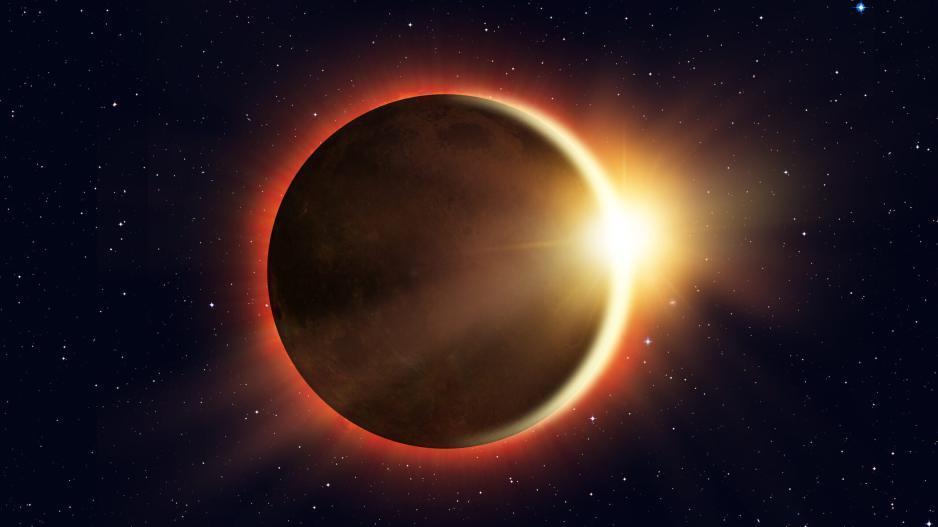Total Solar Eclipse Will Affect Animal Behaviour
Scientists expect a full solar eclipse that will ‘cover’ a large part of the USA in April, in order to, once again, observe the ‘silent’ behaviour of animals.
A solar eclipse occurs when the moon’s disc aligns internally with the solar disc covering every trace of solar light for a couple of minutes, a phenomenon that can have an impressive effect on the behaviour of animals. During previous solar eclipses, people from all over the world have noticed a surreal silence in the animal kingdom, as birds, insects and animals interrupted their normal behaviours because they were confused.
Researchers have noticed all kinds of unusual behaviour in zoos during past eclipses. Flamengo formed a protective circle around their babies, giraffes began galloping around their surroundings, flocks of birds big enough to be spotted by radars suddenly abandoned the skies to hide in tries, while ancient Galapagos tortoises were spotted mating.
With the full solar eclipse that will cover the USA on April 8th, scientists are preparing to observe animals in many zoos, as they were very surprised with their findings in 2017, during the latest full solar eclipse in the USA. ‘’I thought it was nonsense, I didn’t believe they would be affected at all. Clouds pass over them, and they don’t react. It was so ephemeral’’, stated Adam Hartstone-Rose, professor of Comparative Anatomy at the University of Carolina.
For the 2024 eclipse, scientists call citizens to contribute with their observations too. It should be noted that pet animals are also included in the research, as veterinarians say that overall their behaviour won’t be most affected by the sudden darkness but by the behaviour of the people around them. ‘’They will react more to our own reactions, our excitement and stress more than anything else regarding the actual eclipse’’, stated Dr. Rena Carlson, President of the American Veterinary Medical Association.
To set up the research, the professor and his associates instructed more than 40 people to observe 12 animal displays at a zoo in Columbia, South Carolina. They began a few days before the eclipse, to be able to estimate how much the animals’ behaviour changed. It was an ideal place to conduct the experiment. On August 21, 2017, at 14:41 pm, the wider region of Columbia experienced the longest full solar eclipse, compared to any other city on the East Coast, which lasted a little over 2 minutes and 30 seconds.
Over two-thirds of the animals exhibited changed behaviour. More specifically:
Flamengos: The adult ones formed a protective circle around the younger ones and the babies.
Giraffes: Some of them began running around, and stopped only when the sun returned.
Bears: They did not care at all. One of them raised its head during the eclipse, without any further reactions.
Galapagos Tortoises: During the climax of the eclipse, they began procreating.
For the 2024 eclipse, the professor will escalate the animal observations across the country. There will be studies in multiple zoos, which will allow for a larger number of animals to be observed. He will be located at the Fort Worth Zoo, as because of the tortoise findings, he is curious about what the bonobos will do. ‘’They are very sexual animals. When they are stressed, their reaction is to have sex. I am curious to see if their reaction will be to mate’’, he mentioned, among others.
‘’Anyone who has been outside during an eclipse notices two things, the unnatural light and the sudden silence of birds and insects. Animals simply don’t know how to handle eclipses, as they are not biologically adapted to them’’, stated Andrew Farnsworth, a visiting scientist at the Ornithology Lab of Cornell University, who has studied the behaviour of birds during eclipses.
‘’Eclipses are neither frequent nor rare and we, as humans, can calculate them. But for short-lived animals who may not observe astronomy with math, it is rather unexpected’’, he also mentioned. In 2017, a team of researchers and he used a radar to see exactly what the birds were doing during the eclipse, a project they intend to expand during this April’s eclipse. By using 143 meteorological radar stations, they observed the behaviour of several bird species.






